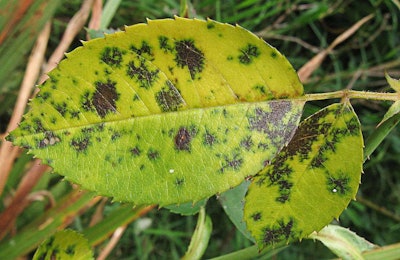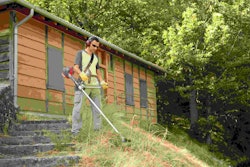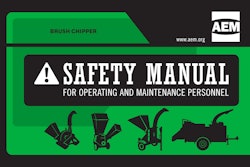 Black spot is one of the common plant diseases that is spread by rain splashes.
Black spot is one of the common plant diseases that is spread by rain splashes.Photo: Wikipedia
Abundant rain sounds like a great thing for thirsty plants. But there is such a thing as "too much of a good thing," too.
Heavy rains that don’t stop often mean floods; they also mean increased risks of plants contracting a disease. Waterlogged roots are never a good thing and for certain species, they spell death by root rot if proper precautions are not taken.
Azaleas, rhododendrons, dogwood, and mountain laurel are just a few of the plant species that are susceptible to phytophthora root rot. It commonly appears in areas where rainwater collects around plant roots. To avoid this, these plants should be placed in a raised bed or mound and out of harm’s way.
Both bacterial and fungal diseases can appear during wet weather. Here’s a list of common plant problems that can result from too much rain and some steps for preventing them:
Anthracnose
Anthracnose is a fungal infection that affects a wide variety of trees and plants. It causes leaf spots, twig cankers, and dieback. It overwinters on the bark of the tree or on fallen leaves and is spread in the spring by rain and wind.
While it will not cause permanent damage to established trees, continual years of defoliation will weaken the tree to other diseases. In order to guard against this fungus, dispose of fallen leaves to lessen the amount of areas it can survive the winter. Prune the plant of infected twigs to improve both light penetration and air circulation.
Powdery mildew
One of the most common fungi to plague plants, powdery mildew covers leaves in a grey-white growth. Although it does not need free water to spread, high humidity encourages spore formation of powdery mildew while low humidity aids in spore dispersal.
Sunlight and heat can kill this fungus so try to place plants in sites that receive at least six hours of light a day. Do not crowd plants, as you want to ensure air can circulate adequately. Fungicides can only be used for prevention and control. There is no product that can eliminate the problem completely.
Black spot
Black spot is caused by a fungus called Diplocarpon rosae and it creates spots on foliage of ¼ inch to 1 inch in diameter. As the disease worsens, it will yellow the tissue around the black spots and cause premature leaf drop.
The fungal spores are spread by rain splashing on new leaves and the fungus can develop if the area has been wet for six to nine hours. Bright sunlight and good air circulation are needed to get rid of black spot. If the plant is already infected, remove the infected material and spray with a fungicidal soap.
For those looking for an organic option, the University of California Integrated Pest Management Program suggests combining four teaspoons of baking soda per gallon of water with 1 percent of narrow-range oil.
Fire blight
Unlike the other diseases listed, fire blight is caused by the bacteria Erwinia amylovora. It is extremely common and affects fruit trees like apple, pear, and quince. Fire blight appears as a reddish, watery ooze coming out of a branch or trunk cankers as soon as the infected plant begins active growth.
Infected flowers and stems turn brown or black and wither. The bacteria spreads through rain and pollinators. There is no cure for fire blight so the best way to control it is by pruning the cankered limbs during the dormant season. Copper products can be sprayed to reduce the bacteria’s ability to survive and reproduce.
Apple scab
Another common fungal disease, apple scab can cause serious damage to ornamental trees and shrubs. It may be found initially as fuzzy, round lesions that appear on leaves and cause them to curl. The spores are released by rainfall and can land to infect flowers, fruit, or leaves.
Severely infected leaves turn yellow and drop. Some cases can lead to total defoliation for trees. As with anthracnose, these leaves should be disposed of as soon as possible.
If it is likely the tree’s leaves will remain wet for nine hours or more, a fungicide should be applied to prevent early infection. There is no point in spraying a heavily infected tree, as the fungicides cannot do much good by then.











